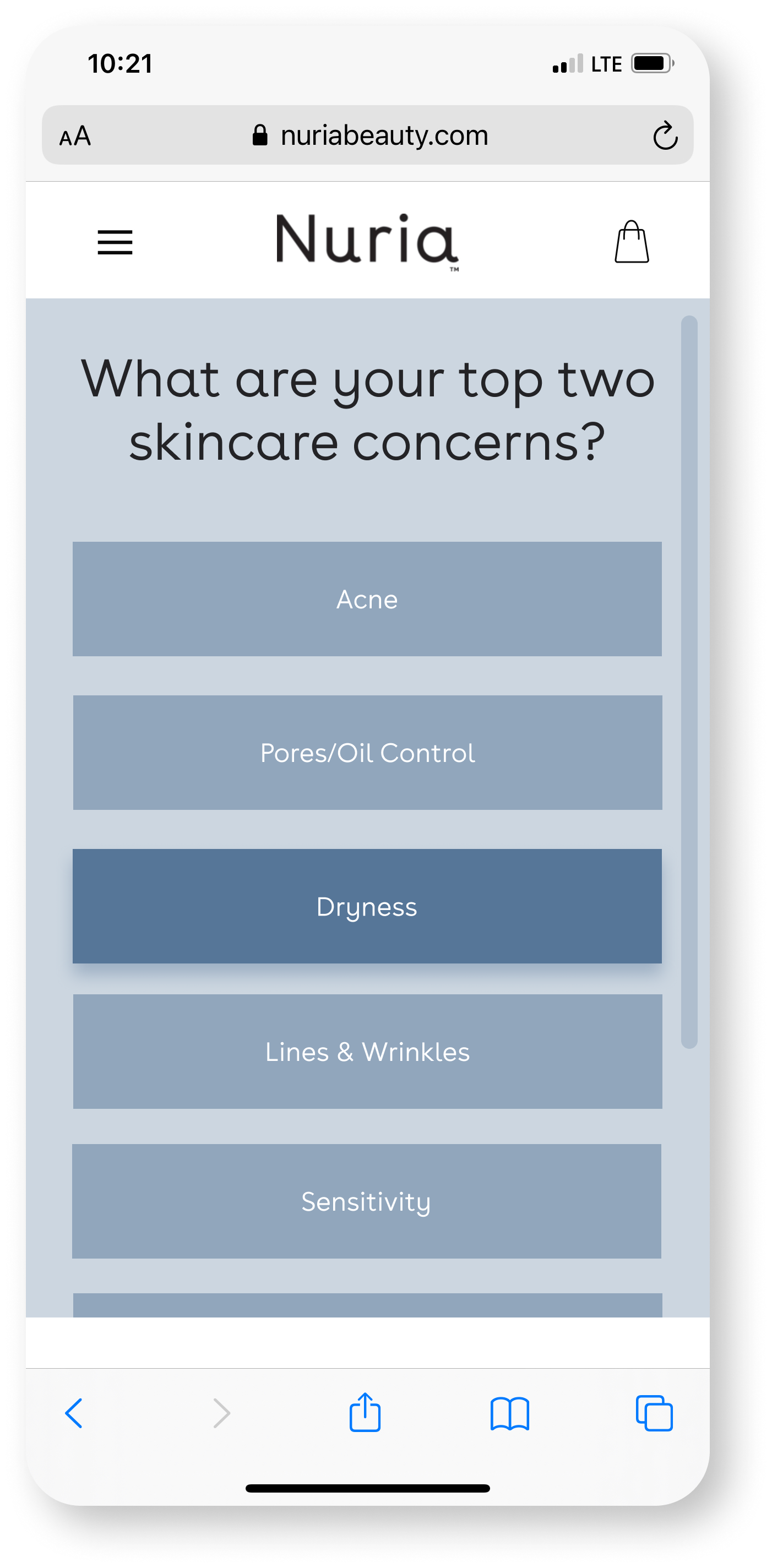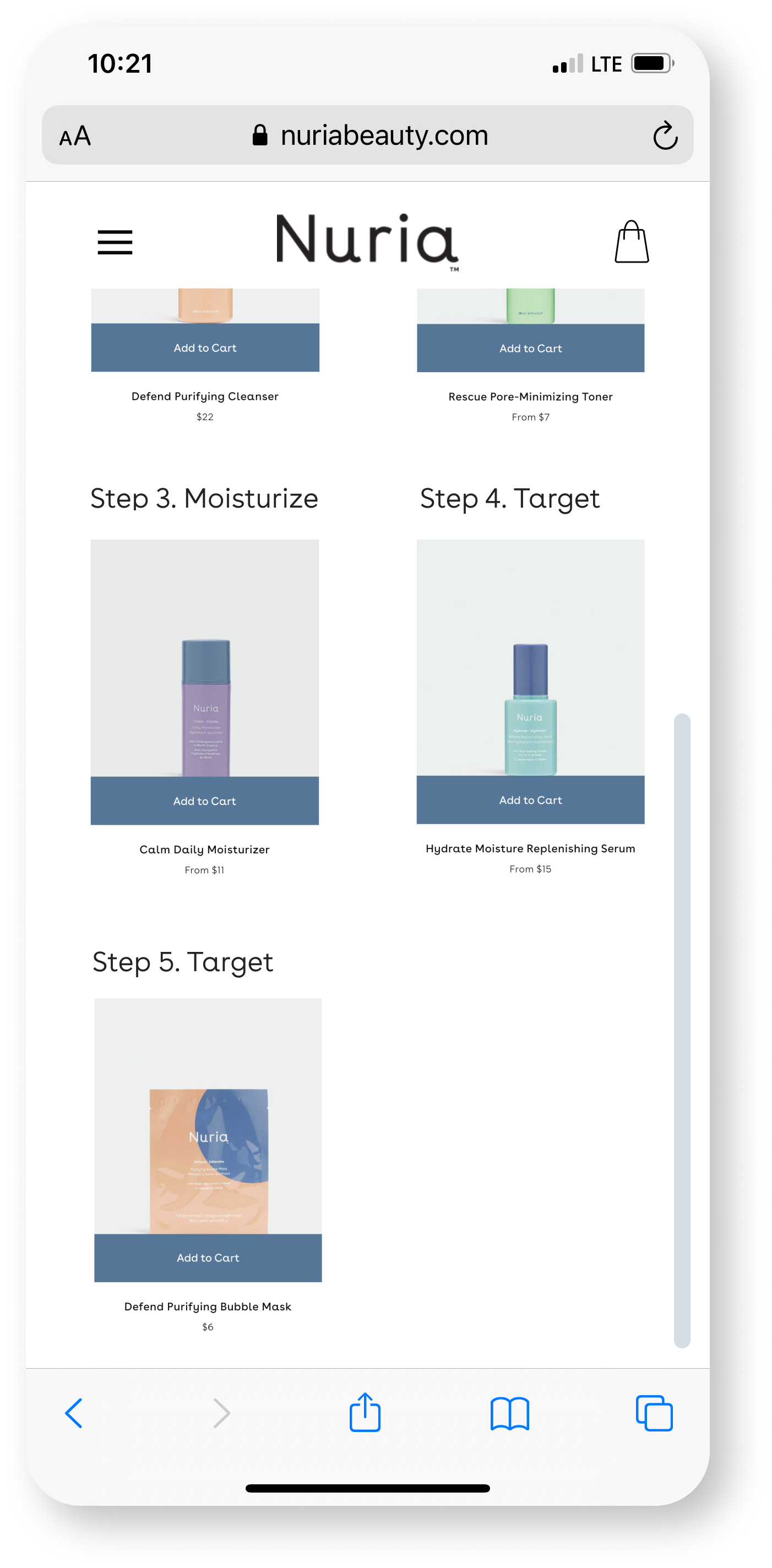
Overview
While working at Nuria Beauty, a start-up skincare brand, I developed a recommendation quiz for the website that generates a custom skincare regimen based on a consumer’s lifestyle and skin needs.
My Role:
User Research, quiz logic & development, visual design, prototyping & testing.
I worked in tandem with the product development team and engineers in the development, implementation, and iteration of the quiz on nuriabeauty.com.
Background
Nuria is a vegan, cruelty free, carbon neutral skincare brand with products inspired by global beauty wisdom.
Project Vision and Objectives:
To design and develop a product recommendation tool for nuriabeauty.com consumers that will lead to increased website conversion.
My Process
Research
I conducted a thorough competitive analysis of other product recommendation quizzes in the industry. Looking at best practices to guide the development of our tool. I leveraged the brand’s existing target consumer profile to form a deeper understanding of the end-user and what their goals and needs are.
Competitive Analysis Key Findings
Most competitor quizzes include a question directly asking the user what their most important skincare concerns or need is (Eg. breakouts, dullness, dryness, fine lines, etc.)
All competitor quizzes were formated for mobile adaptability and we noted a mobile-first attitude as customers were likely to be engaging with the quiz through their mobile devices.
The most common quiz result format included a specific skincare routine as opposed to a list of recommended products. This gives the consumer direct action steps on how to implement the results into their lifestyle. This should lead to an increased likelihood of conversion as the user can more easily imagine the direct application.
The average quiz length consisted of 5 to 10 questions. A user’s time is limited and valuable so it’s important to keep the quiz as short as possible while still gaining all the information needed to make a recommendation.
Most competitor quizzes gave users at least three products in their results. This guided our approach as three products are the minimum required to create a Nuria skincare routine. Our website data suggests consumers will most often purchase two to three products in an order, thus recommending at least three products makes sense.
What’s important to our consumer “Ali”?
Ease and convenience
Tangible results
Feeling empowered in her choices
Personalization
When taking into consideration what Ali needs from a product recommendation tool, ease and convenience are important as her time is valuable. We want to develop quiz questions that make Ali feel heard, and that help her understand that we are taking into consideration her specific situation and needs. Ali is not a “beauty guru” who has extensive skincare knowledge, she needs assistance in finding the right products. This is why Ali might find a quiz that curates a step-by-step skincare routine for her to be the easiest and most convenient solution.
Quiz Development
Quiz Logic and Development
When forming questions we took into consideration what information we would need to know to create a custom skincare routine. This included: length of routine (minimal, in-between, extensive), their age, the climate they live in, skin concerns, and stress levels.
Result Format
I started by designing the quiz results and identifying their key components. The table on the right outlines all possible outcomes. Research revealed that our consumers vary in the time and effort they are willing to dedicate to skincare routines.
This insight led to three result formats tailored to users’ preferences: short, medium, or long routines. All users are recommended a cleanser, toner, and moisturizer. Medium-length routines include an additional treatment product, like a mask or exfoliator, while long routines add a second treatment product, such as a serum, essence, or eye cream.
Developing the logic matrix of the quiz
To develop the quiz logic, I collaborated with the product development team to understand each product’s purpose, usage, and target audience. Using this knowledge, I created a robust logic matrix mapping quiz questions to result options. Below is a preview of the matrix.
Usability Testing & Iteration
I collaborated with the engineering team to develop and test the quiz, refining the logic matrix along the way. I also created a user flow diagram for integrating the quiz into the site. Usability testing revealed that asking for users’ email addresses at the start of the quiz was a pain point, causing some to drop off. Moving this step to the end increased engagement, as users were more likely to continue after investing time and effort into completing the quiz.
User Flow
Final Prototype
















